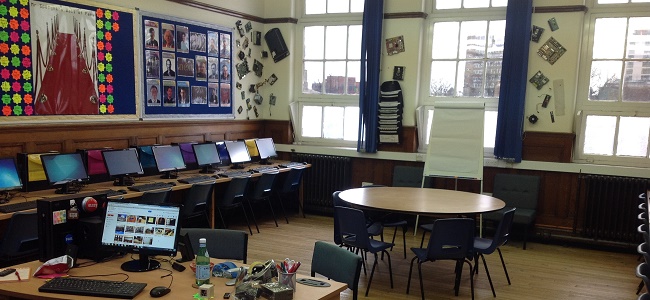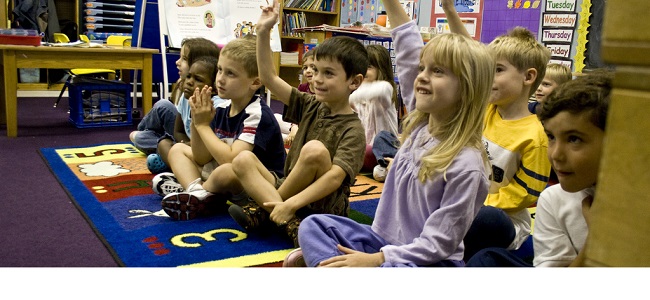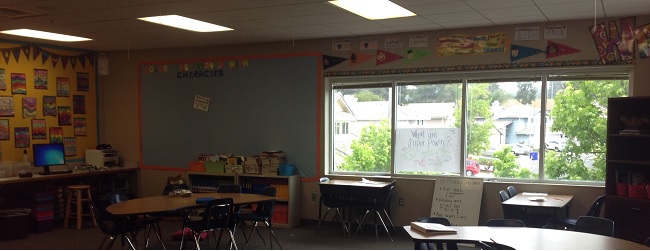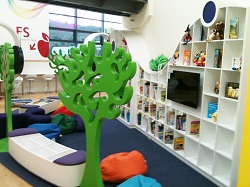Is the traditional classroom setting too archaic? Computer Science teacher Adam Speight looks at how he’s designed his Kings Monkton School classroom with progressive learning in mind.

The traditional model of what a secondary school looks like from the outside is diminishing all the time. If you look at any new schools which are being built you will see that vast amounts of money are being spent on how they look cosmetically-speaking. However, look inside them and you’ll see the classrooms within look very much the same as those found within traditional school buildings. This is because these classrooms are normally designed so that the desks are arranged in long lines and the teaching experience is very much teacher-led. This is a big problem, because if learners are to be fully engaged within a learning environment, then the learning environment must be designed in a way which suits them and enhances both teaching and learning.
After enrolling on a mindfulness course, I embarked upon a personal journey into mindfulness and its benefits. It is something I felt so passionately about that I decided to bring mindfulness into the classroom. There are many definitions of mindfulness out there, but the one I choose to share with the children is “Mindfulness is paying attention to your life, here and now with kindness and curiosity” (www.mindfulnessfoundation.org).
What is SOLE, and how can it be used to innovate education. Taking the the lead from Sugata Mitra, e-learning consultant Jacqueline Emkes illustrates how she’s utilised this learning method to achieve inspiring results.

I am a roving e-Learning Consultant based at Biddenham International School and Sports College (BISSC) in Bedford. In 2012, I was asked to take a lead on 'SOLE' learning sessions with a group of home-educated children on the PLACE Scheme, a parent -led and community based support programme for home educating families. It is commissioned by Bedford Local Authority and administered through BISSC. To be eligible for the scheme children must be on the Elective Home Education Register of the local authority in which they live.
People sometimes mistake the concept of pupil engagement for frivolous, time-wasting fun. In fact, in any school staff room it’s likely that there will be at least one colleague shaking their head sadly and muttering the word “Edutainment” when particular classroom approaches are mentioned. The thing is, sometimes that cynicism is entirely reasonable; sometimes a wariness about “play” in the classroom is absolutely warranted. Why? Because there is an overwhelmingly important distinction between inspiring intrigue and engagement in a topic or skill, and simply sugar-coating the work with a meaningless, superficial “fun” activity.
Sometimes, no matter how hard you try to engage students with an interesting lesson, their minds still wander. San Diegan teacher Kriscia Cabral considers laughter to be an important part of any school day, and a vital element in keeping pupils present.

The great E.E. Cummings once said, “The most wasted of days is one without laughter.” Laughter in and out of the classroom is sunshine to our souls. It is a powerful tool and can be ignited when shared with your students. How can you empower students with laughter? Give them the opportunity to laugh out loud!
How can you get the most out of your pupils? Do you make sure that their days are strictly regimented, in order to make sure a curriculum is thoroughly covered? Or do you, as Kriscia Cabral ponders, throw seating plans to the wind in order to give students a psychological boost?

I’ve had a number of conversations with my colleagues about no assigned seating in the classroom. I made some attempts around this idea last year; however, at the start of this year I decided to go full throttle. And I am so glad that I did. Allowing my students to come in every morning and have a choice is the first empowering decision they get to make in their day. Not only to do I no longer have the task of rearranging my seating on a monthly basis, I don’t have to waste valuable learning time with finding order in the classroom again.
At the beginning of the year I wrote a post for Scholastic discussing the design of my room. I talked briefly about the seating, but I’d love to highlight here how you can take small steps along this amazing journey to classroom seating freedom.

If you have a kid of your own who reads, where does he/she sit when reading at home? Everywhere and anywhere is the answer.
They lay on the floor, they slouch on a sofa or sit upside down on a sofa hanging over the arm.
They don’t of their own volition sit at a desk or table. Why? Because, duh, it’s not comfortable!
If you want kids to read and lose themselves in a story, or use iPads or other devices naturally as they would at home, then give them beanbags, floor pads, soft bucket seats and sofas. If they need a desk, just make it comfy to sit at.

A community-driven platform for showcasing the latest innovations and voices in schools
Pioneer House
North Road
Ellesmere Port
CH65 1AD
United Kingdom